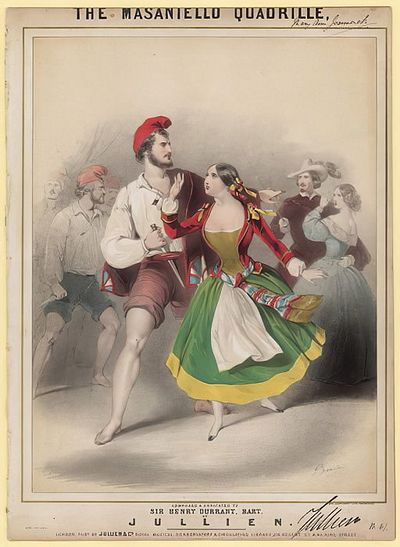Annotation:Bacarole in Masuniello: Difference between revisions
(Created page with "{{TuneAnnotation |f_annotation='''BACAROLE IN MASUNIELLO.''' English, Air (6/8 time). G Major. Standard tuning (fiddle). AABB. '''Masuniello''' was a ballet by Daniel Auber....") |
No edit summary |
||
| (4 intermediate revisions by the same user not shown) | |||
| Line 1: | Line 1: | ||
{{TuneAnnotation | {{TuneAnnotation | ||
|f_annotation='''BACAROLE IN MASUNIELLO.''' English, Air (6/8 time). G Major. Standard tuning (fiddle). AABB. ''' | |f_annotation=[[File:Masaniello2.jpg|thumb|400px|right|Masaniello]]'''BACAROLE IN MASUNIELLO.''' English, Air (6/8 time). G Major. Standard tuning (fiddle). AABB. '''La muette de Portici''' (The Mute Girl of Portici, or The Dumb Girl of Portici), also called '''Masaniello''' in some versions,[1] is an opera in five acts by Daniel Auber, with a libretto by Germain Delavigne. It was first staged in 1828 at the Paris Opera. The tune, as a bacarole, a traditional folk song sung by Venetian gondoliers or a piece of music composed in that style, was published in London in 1829 by T. Valentine, who also published a set of quadrilles from the balled in 1830. The tune was entered in the mid-19th century music manuscript of William Winter, a shoemaker and violin player who lived in West Bagborough in Somerset, southwest England. | ||
|f_printed_sources= | |f_printed_sources=Geoff Woolfe ('''William Winter’s Quantocks Tune Book'''), 2007; No. 131, p. 52 (ms. originally dated 1850). | ||
}} | }} | ||
Latest revision as of 02:47, 15 July 2023
X:1 T:Bacarole in Masuniello M:6/8 L:1/8 S:William Winter music manuscript (1850, p. 13, Somerset) K:G d/c/|B2B Bcd|e3-d2B|d2c A2A|B2A G2A| B2B Bcd|e3- d2B|d2c A2B|G3-G2:| |:B|A2A A2A|cBA G2d|...


